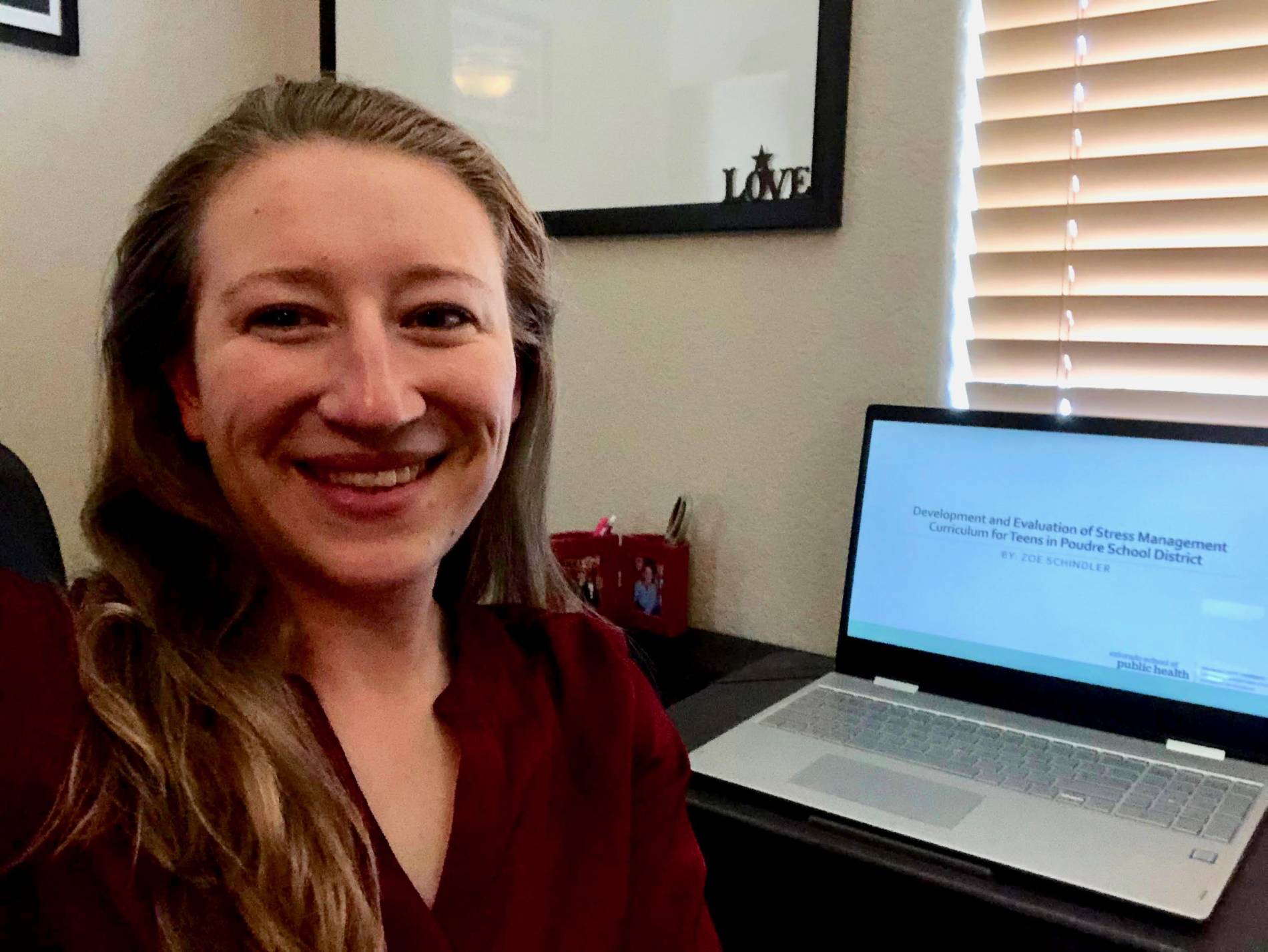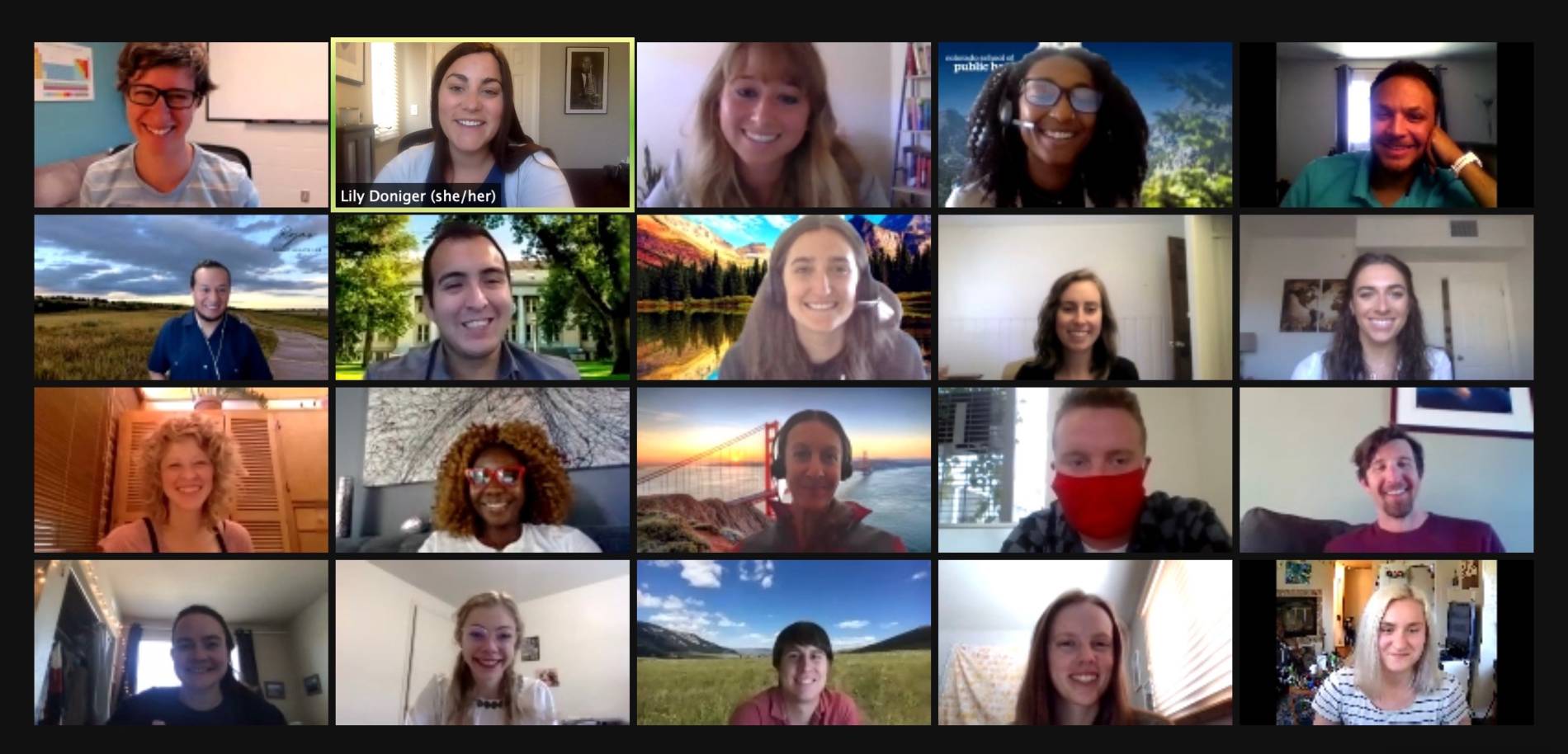MPH students prepare all semester long to present their capstone projects at the Public Health Forum. Held virtually again this semester due to the COVID-19 pandemic, many students completed their presentations as one of the last things to do before they graduated. It was a year full of change and challenges as classes shifted online and students had to adapt to a real-world public health crisis. Despite that, students persevered and produced relevant and important capstone projects that positively impacted their communities.
Zoe Schindler, in the Physical Activity and Healthy Lifestyles concentration at the ColoradoSPH at Colorado State University, focused on reducing stress in teens for her capstone project. High school teens are facing high levels of stress due to rising homework loads, expectations to get into college, and social pressure to fit in, not to mention the added emotional and physical stress due to the global COVID-19 pandemic. Using topics discussed in “The Upside of Stress”, a book by Kelly McGonigal, Zoe designed 6 lessons to teach teens how to reframe stress to be a positive tool.
“The lessons are all about learning how to shift your mindset around stress to think of it as something that you can use to your advantage rather than something that hinders you” said Zoe.

Zoe enjoyed her capstone project because it gave her the freedom to work on a project that she felt was very meaningful for the community she wants to work with in the future. She wants to continue to make a difference in improving the health of youth in Colorado and working on a project that focused on mental health was a great first step for that.
For his capstone project, Will Rausch, in the Animals, People and the Environment concentration, worked with the National Park Service to understand the prevalence, demographic, and biological risk factors of Echinococcus and Taenia (TA) infections within Isle Royale wolves. These infections are highlighted by many anti-wolf reintroduction organizations as being a large public health concern, however, they generalize the public health risk of the Echinococcus genus with the species.
“I used RStudio to create linear models to assess the relationship between the demographic data and infection status, which is something I learned about in my MPH coursework” said Will.
Will found that being a wolf pup has a statistically significant relationship with granulosus infections, which can harm the host but most likely will not kill them. No other demographic data was found to have a statistically significant relationship with any Echinococcus infections. This finding is consistent with immunology, which states that young animals have an underdeveloped immune system and is a possible explanation for this finding.
“The overall prevalence of granulosus infections are low, showing that the overall public health risk of reintroducing wolves from an Echinococcus perspective is low, going against common anti-wolf reintroduction rhetoric” said Will.

“I could not have asked for more supportive preceptors, advisors, professors helping me along the way. When I set out to find a capstone project, I was looking for something that would expand on my knowledge of biostatistics and incorporate animals, people, and the environment, and I was able to achieve all these goals with this project” said Will.
Mayra Ramirez, also in the Animals, People and the Environment concentration, looked at impacts of environmental exposures in horses for her capstone project. The focus of her project was to assess the relationship between geographical factors, including altitude, latitude, and annual UV exposure, and the probability of a neoplasm being diagnosed as UV-induced in the horse.
“Comparative statistical analysis determined that after adjusting for all environmental covariates, only altitude and latitude were statistically significant. The results demonstrated the imperative role horses can play as sentinel animals for humans” said Mayra.
Since horses spend most of their time outdoors, are in direct sunlight and ultimately have all of their skin exposed to Ultraviolet radiation (UVR), clinical signs that develop in their lifespan can be studied and used to evaluate the development of UVR induced skin cancer in humans. The health of horses promotes a One Health approach because they contribute to the health of humans, through behavioral therapy, companionship, recreation and work, in addition to the health of the environment by improving the earth and biodiversity.
“I used almost everything I learned in my MPH courses to complete my capstone, I actually used lectures and notes that had saved from previous classes! The GIS in Public Health class with Dr. Magzamen and Dr. Gutilla was key for the success of my capstone and the One Health class with Dr. Salked really helped bring the big picture together for me” said Mayra.

Mayra would love to work with projects that take on a One Health approach in her future career.
“It’s critical for public health professionals to take into account the health of all three sectors and think interdisciplinary for the best outcomes and solutions” she said.
All three students are now MPH graduates and will continue their important work as public health professionals. Their capstone projects helped them learn more about the many public health opportunities out there and their MPH coursework has set them up for success. Good luck and congratulations to Zoe, Will, and Mayra and all the other MPH graduates of spring 2021!
Written by Megan Jansson

